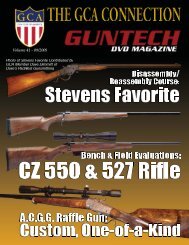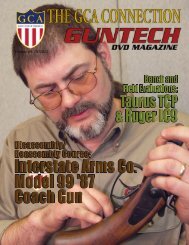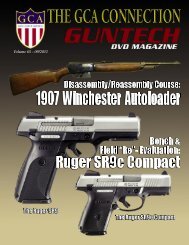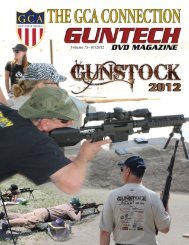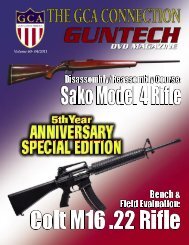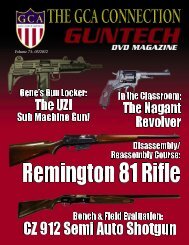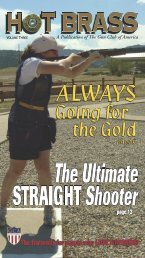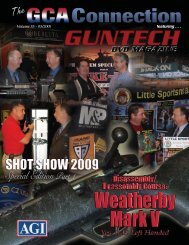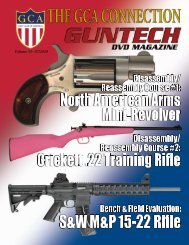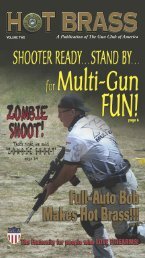GCA-Newsletter_12_12.. - Gun Club of America
GCA-Newsletter_12_12.. - Gun Club of America
GCA-Newsletter_12_12.. - Gun Club of America
You also want an ePaper? Increase the reach of your titles
YUMPU automatically turns print PDFs into web optimized ePapers that Google loves.
S n i p e r s<br />
Part 2 <strong>of</strong> 2<br />
Contributed by Robert Dunn,<br />
AGI/<strong>GCA</strong> Video Producer, AGI Pro Course Graduate, <strong>GCA</strong><br />
Charter Member, and a Certified Law Enforcement Armorer<br />
As with military sniper teams, police snipers operate in<br />
two-man teams. Police snipers are usually part <strong>of</strong> a SWAT<br />
division and will go where they are needed to provide support<br />
for their unit. Countersniping tactics are also utilized by the<br />
Police Sniper.<br />
Different operations demand different weapons systems to<br />
accomplish the sniper’s mission. In most Law Enforcement<br />
scenarios, the range <strong>of</strong> engagement is usually inside 100<br />
yards. The Police Sniper must consider the many legal ramifications<br />
and laws before taking a shot.<br />
A display <strong>of</strong> different models <strong>of</strong> Remington Sniper Weapon Systems<br />
A common chambering for a police sniper rifle is the .223<br />
Remington (equivalent to the military’s 5.56x45mm NATO<br />
cartridge), as it is a round that will not overpenetrate. The .308<br />
Winchester (equivalent to the military 7.62x51mm NATO cartridge)<br />
is a cartridge that would be good for shooting through<br />
glass or for a longer engagement distance. Some SWAT units<br />
and other agencies employ the .50 BMG cartridge, however,<br />
the need to stop a bus or a train does not come up very <strong>of</strong>ten.<br />
The Military, on the other hand, can utilize the energy<br />
unleashed by the .50 BMG cartridges on a daily basis! In a<br />
war zone, it may be very necessary to disable a car, a bus, a<br />
train, or even an aircraft.<br />
The .50 caliber round is used for ordnance disposal and<br />
detonating IEDs and car bombs from a safe distance, as well<br />
as taking out s<strong>of</strong>t and hard targets. If you need penetration,<br />
the .50 BMG and a Barrett Model 82A1 (M107) rifle would be<br />
a good choice!<br />
Some <strong>of</strong> the other firearms and chamberings currently used<br />
by the military are: the M14 in 7.62x51mm NATO, the M24 bolt<br />
action rifle (the US Army’s equivalent <strong>of</strong> the Remington<br />
Model 700) in 7.62x51mm NATO, the M40 bolt-action rifle (the<br />
10<br />
US Marine Corps’ equivalent <strong>of</strong> the Remington Model 700) in<br />
7.62x51mm NATO, and the M110 SASS (Semi-Automatic<br />
Sniper System) rifle, which is manufactured by Knight’s<br />
Armament Company. Other cartridges in use are the .338<br />
Lapua Magnum and the .300 Winchester Magnum.<br />
A sniper’s rifle, first and foremost, must be extremely accurate<br />
and reliable. The optics must be just as good as the rifle itself.<br />
Leupold, Nightforce and Schmidt & Bender come to mind<br />
when it comes to quality scopes. A bipod can be a handy<br />
addition to a sniper rifle, as it <strong>of</strong>fers stability for accuracy and<br />
follow up shots. A suppressor can aid in masking your shooting<br />
position or hide and should be considered for certain missions.<br />
Muzzle brakes certainly have their place in taming<br />
recoil, however, steps must be taken to hide the dust and<br />
debris from the increased muzzle blast and the report <strong>of</strong> the<br />
rifle is significantly louder.<br />
Before being selected for sniper school, you must be found to<br />
be both mentally and physically fit. A sociopath or someone<br />
hung up on "thou shall not kill" would not make a good candidate.<br />
As you might suspect, a sniper's training first consists<br />
<strong>of</strong> being taught expert marksmanship. Without scoring high<br />
in this category, further teaching becomes a moot point. All<br />
types <strong>of</strong> shooting are taught, from handguns to the Barrett .50<br />
caliber rifle. Snipers learn about firearms maintenance,<br />
design and function, ballistics, bullets, optics, wind and range<br />
estimation, man-tracking, survival techniques, and shot<br />
placement. Scope sight picture, shooting position, breathing<br />
patterns, grip, trigger control, and follow-through are all<br />
emphasized to achieve the best accuracy.<br />
Good physical conditioning is always a requirement. You have<br />
to be able to make an accurate shot, even when you are<br />
exhausted. It might be really physically challenging to get<br />
yourself into an optimal shooting position. Once you are in<br />
position to make the shot, it might be hours or days before<br />
you can actually take the shot. This takes a person that is<br />
patient and one who is physically capable <strong>of</strong> staying in a<br />
cramped position for a really long period <strong>of</strong> time.<br />
Camouflage and concealment are important factors in<br />
sniping. When people can see you, they will kill you! One <strong>of</strong><br />
the most useful tools for camouflage is the Ghillie suit. This is<br />
a type <strong>of</strong> clothing used for concealment and incorporates the<br />
colors, shapes and foliage <strong>of</strong> the environment the sniper is<br />
working in. The full Ghillie suit includes a hat (sometimes with<br />
a veil), gloves, a jacket, a pair <strong>of</strong> pants and usually some type<br />
<strong>of</strong> camo wrap for your rifle. A Ghillie suit can be made by<br />
attaching strips <strong>of</strong> burlap, jute twine and cloth to a BDU (battle<br />
dress uniform) or to some coveralls. The strips <strong>of</strong> cloth can<br />
be painted the colors that will enable you to blend in with




